


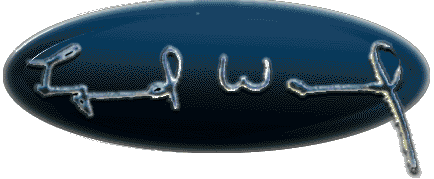
It's said that Lynd Ward decided to be an artist when, in the first grade, he realized that "draw" was "Ward" spelled backwards. He was born in Chicago in 1905. He studied art at Teachers College, Columbia University (the same college attended by Dorothy Lathrop) and graduated in 1926. He married May McNeer the week they graduated and immediately sailed for a year in Europe.
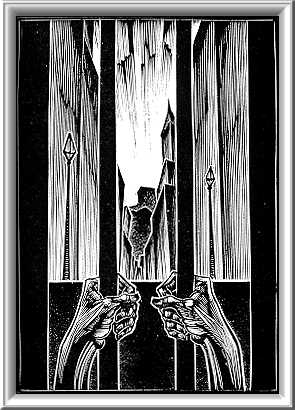 Ward
spent much of that time attending the Leipzig Academy for Graphic
Arts where he was taught the art of wood engraving by Hans
Alexander Mueller. He was also exposed to the work and ideas of
the Belgian Frans Masereel and the German Otto Nuckel. Both of
these artists were exploring the limits of telling stories with
pictures and no words. That year and those artists had an indelible
impact on Ward and his career. When the Wards returned to the
U.S., Lynd was already hard at work honing his illustrative talents
and planning his first novel without words. This was to be Gods'
Man in November of 1929 (shown at left). It was his
first published "writing", though he had already illustrated
the works of others, including Prince Bantam by McNeer
earlier in 1929. With 139 images engraved on wood and printed
on one side of the page, Gods' Man (note the apostrophe
position) was as thick as a 290 page text novel and sold quite
well despite having been released the week of the stock market
crash. It was in its third printing by January of 1930.
Ward
spent much of that time attending the Leipzig Academy for Graphic
Arts where he was taught the art of wood engraving by Hans
Alexander Mueller. He was also exposed to the work and ideas of
the Belgian Frans Masereel and the German Otto Nuckel. Both of
these artists were exploring the limits of telling stories with
pictures and no words. That year and those artists had an indelible
impact on Ward and his career. When the Wards returned to the
U.S., Lynd was already hard at work honing his illustrative talents
and planning his first novel without words. This was to be Gods'
Man in November of 1929 (shown at left). It was his
first published "writing", though he had already illustrated
the works of others, including Prince Bantam by McNeer
earlier in 1929. With 139 images engraved on wood and printed
on one side of the page, Gods' Man (note the apostrophe
position) was as thick as a 290 page text novel and sold quite
well despite having been released the week of the stock market
crash. It was in its third printing by January of 1930.
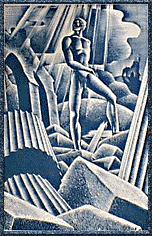 Ward
was to produce five additional novels in woodcuts, Mad Man's
Drum, Wild Pilgrimage, Prelude to a Million Years,
Song Without Words, and Vertigo, by 1937 as well
as wood-engraved illustrations for editions of Faust, Frankenstein,
and others. Now That the Gods are Dead was published in
1932 in a signed limited edition of 400 and contained four striking
wood-engraved plates printed in blue/green ink (see right). The
illustrations for all of these (and other) books, plus many of
his wood-engraved Christmas cards and prints can be found in the
1974 Storyteller Without Words which also features his
comments on the medium and on his work. Nothing matches the clarity
and impact of the originals, but it is an impressive collation
of a large body of work.
Ward
was to produce five additional novels in woodcuts, Mad Man's
Drum, Wild Pilgrimage, Prelude to a Million Years,
Song Without Words, and Vertigo, by 1937 as well
as wood-engraved illustrations for editions of Faust, Frankenstein,
and others. Now That the Gods are Dead was published in
1932 in a signed limited edition of 400 and contained four striking
wood-engraved plates printed in blue/green ink (see right). The
illustrations for all of these (and other) books, plus many of
his wood-engraved Christmas cards and prints can be found in the
1974 Storyteller Without Words which also features his
comments on the medium and on his work. Nothing matches the clarity
and impact of the originals, but it is an impressive collation
of a large body of work.
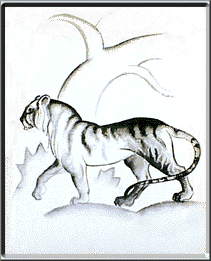 It's
a mistake to think of Ward only as a wood-engraver. Even during
his first decade he was producing a wide range of illustrative
material in a rich variety of styles. Prince Bantam, mentioned
earlier, has a painted color frontispiece (repeated as the dust
jacket) and very tight pen and ink and detailed stippling combined
with some surprising flowing brush work. The storm-tossed ships
at sea below is a good example. The luscious watercolor tiger
at left is from The Cat Who Went to Heaven (1930) and the
early experiment in color wood block printing below is from Waif
Maid, also 1930 and also a collaboration with May McNeer.
1939 saw the publication of Ward's interpretation of Beowulf,
which he rendered in a soft but angular lithographic crayon (?)
style. The limited palette of brown and blue seems to heighten
the tension and drama. See the image below of Beowulf tearing
Grendel's arm off for a sample.
It's
a mistake to think of Ward only as a wood-engraver. Even during
his first decade he was producing a wide range of illustrative
material in a rich variety of styles. Prince Bantam, mentioned
earlier, has a painted color frontispiece (repeated as the dust
jacket) and very tight pen and ink and detailed stippling combined
with some surprising flowing brush work. The storm-tossed ships
at sea below is a good example. The luscious watercolor tiger
at left is from The Cat Who Went to Heaven (1930) and the
early experiment in color wood block printing below is from Waif
Maid, also 1930 and also a collaboration with May McNeer.
1939 saw the publication of Ward's interpretation of Beowulf,
which he rendered in a soft but angular lithographic crayon (?)
style. The limited palette of brown and blue seems to heighten
the tension and drama. See the image below of Beowulf tearing
Grendel's arm off for a sample.
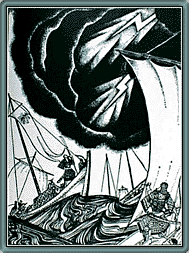
|
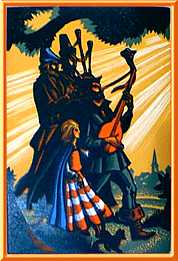
|
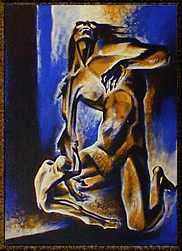
|
| Prince Bantam | Waif Maid | Beowulf |
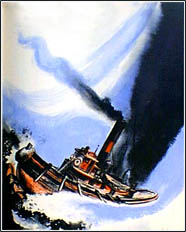
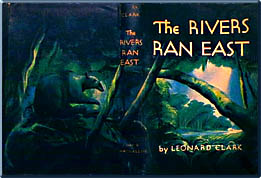 An exhaustive
list of his books is beyond the scope of this essay. Throughout
the Forties and Fifties, though he occasionally did an adult illustrated
book, his focus was children's books. Some, like The Little
Red Lighthouse (1942, left), were for other authors, but more
and more he wrote his own material or collaborated with May McNeer.
A series of biographies of famous Americans featured Paul Revere,
Ethan Allen, Robert E. Lee, John Muir, and others. The Biggest
Bear in 1952 won him the Caldecott Medal for 1953. Dust jacket
paintings continue to turn up, providing us with new images. The
Rivers Ran East is a verdant view of a South American rain
forest. His illustrations appeared often in Boy's Life
in the early Sixties.
An exhaustive
list of his books is beyond the scope of this essay. Throughout
the Forties and Fifties, though he occasionally did an adult illustrated
book, his focus was children's books. Some, like The Little
Red Lighthouse (1942, left), were for other authors, but more
and more he wrote his own material or collaborated with May McNeer.
A series of biographies of famous Americans featured Paul Revere,
Ethan Allen, Robert E. Lee, John Muir, and others. The Biggest
Bear in 1952 won him the Caldecott Medal for 1953. Dust jacket
paintings continue to turn up, providing us with new images. The
Rivers Ran East is a verdant view of a South American rain
forest. His illustrations appeared often in Boy's Life
in the early Sixties.
 In 1973
Ward returned to the story without words with The Silver Pony,
the story of a lonely boy and a flying horse done in a lithographic
style.
In 1973
Ward returned to the story without words with The Silver Pony,
the story of a lonely boy and a flying horse done in a lithographic
style.
Lynd Ward died in 1985.
In 2001 a new book, Lynd Ward's Last unfinished Wordless Novel was published in an edition of 125. It consisted of 26 plates reproduced directly from the engraved blocks that were left at the time of his death. The completed novel was supposed to be 44 plates, so the story was a bit chaotic and hard to decipher. But at $150, just the 26 original Ward woodblock prints were a bargain.

To find out more about Lynd Ward, see:
| Storyteller Without Words | Lynd Ward, 1974 Harry N. Abrams |
| The Art of the Fantastic | Gerry de la Ree, 1978 de la Ree |
| Caldecott Medal Books: 1938-1957 | Bertha Mohony Miller & Elinor Whitney Field, 1957 The Horn Book |
| The Vadeboncoeur Collection of Knowledge | Jim Vadeboncoeur, Jr., 1998 |
|
Illustrations copyright by their respective
owners. This page written, designed & © 1998 by Jim Vadeboncoeur, Jr. Updated 2011. |
